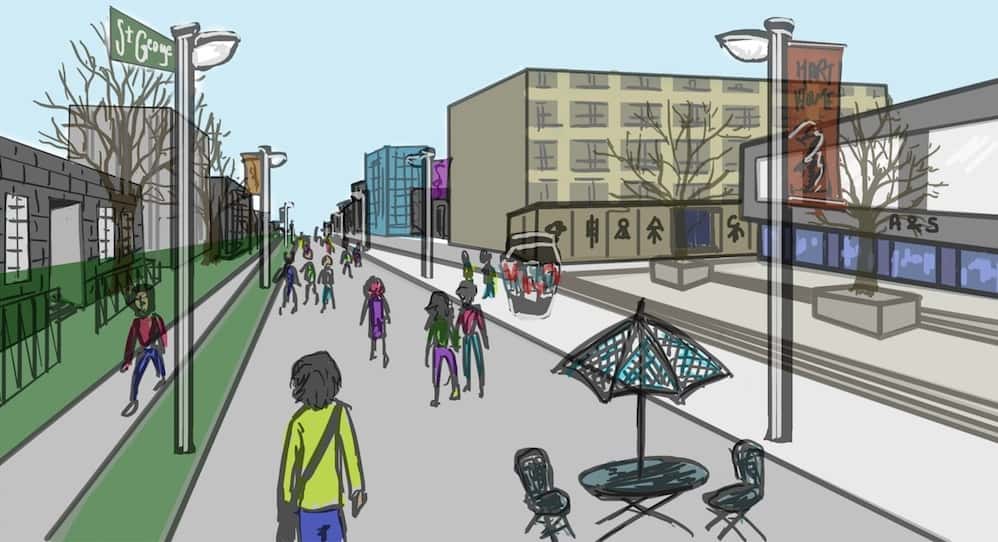The University of Toronto Students’ Union (UTSU) is continuing its campaign to pedestrianize a portion of St. George Street, but are facing an uphill battle with university administration and the City of Toronto.
The UTSU has been raising this issue for over two years. Under current president Munib Sajjad, the UTSU began to study the issue in March 2013. Previous president Shaun Shepherd campaigned for the change in the spring of 2012. Neither the university administration nor the city has heard of any recent developments of the campaign. They also stated that there are no active plans to pedestrianize St. George Street.
“The only thing I’ve heard about it I’ve read in The Varsity,” said Scott Mabury, vice-president, university operations. “We have no plans, not studying, not looking into closing St. George because of the overall potential ramifications to the campus.”
The university considered pedestrianizing St. George Street, Devonshire Place, and Willcocks Street in a pilot project four years ago. The university’s plan for St. George Street called for a closure north of Russell Street up to the loading dock of the Sidney Smith and Ramsay Wright laboratories. The problem was that the traffic would spill onto Huron Street, a narrow street with parking on one side.
“We did not implement at that time anything on St. George because the potential disruption factor was just huge. Having a change to St. George that makes something else much more materially worse is not something that we can easily go into,” said Mabury.
A portion of Willcocks Street has now been permanently closed to traffic. Once more, the university is looking into pedestrianizing a part of Devonshire Street, which was closed due to construction of the Goldring Centre, said Mabury.
Despite the obstacles, Sajjad said that there may be some in U of T’s administration that support the idea. He plans to introduce the idea to U of T president Meric Gretler when the UTSU meets with him later in the term.
“It’s all about raising the fact with the administration,” said Sajjad. “If there’s a fear of increase of traffic and endangering streets, we are going to show how it’s going to go and how safe it’s going to be.”
The proposal would have to be approved by City Council, and prove that the pedestrianization of St. George Street would be useful for the community.
“Looking to close St. George, that’s a major exercise,” said Fiona Chapman, the City of Toronto’s pedestrian projects manager. Chapman said that this would involve looking at local traffic laws and the local traffic network to see the feasibility of such a project. While there is no one way to begin the process, the recommended first step is to approach the local city councillor.
Sajjad said that Adam Vaughan, the Ward 20 councillor, supports the idea. Vaughan could not be reached for comment as of press time. Even with the local councillor’s backing, Chapman said that the decision would ultimately rest with City Council, and that they would likely not support the closure.
“It can be a challenge to try and close a street in Toronto and then find that it’s not heavily used by pedestrians,” said Ward 27 councillor Kristyn Wong-Tam, who is the local councillor for Ryerson University. Wong-Tam worked to close Gould Street, which bisects the campus. She said that closing Gould Street was a long process completed in increments, with a lot of consultation with local business and community groups.
“Gould Street works so well because of the heavy density of pedestrian traffic,” said Wong-Tam. She added that St. George Street does not have the same pedestrian density at all times of day, and therefore may not be as successful as a pedestrian-only zone.
Tim Grant, chair of the Harbord Village Residents’ Association, agrees. He said that while St. George has heavy pedestrian traffic during the day, it is nearly empty after 9:00 pm. Grant said that the ideal proposal would keep the street open at night when there is less pedestrian traffic, and include bike lanes during the day.
“The problem with all these things when you put time limits… is the changeover. It’s five minutes to [the changeover], five minutes after, where cars aren’t sure where they can go,” said Grant. Despite his concerns, Grant supports the idea.
Paul Kulig, principal of Regional Architects — which was associated with the St. George Street redesign in 1997 — said that the full pedestrianization of the street may not be practical.
“The most successful streets are ones that allow for a mix of uses but where the pedestrians are still dominant,” Kulig said. “We felt [the design] found a balance that maintained the vitality and life in that street.”


